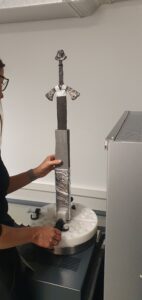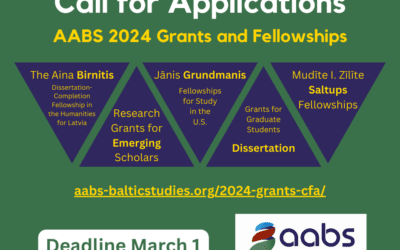AABS is pleased to recognize Andrius Janionis for the completion of the grant associated with his dissertation “The Sword Production Technologies in the Territory of the Baltic Tribes in 10th-15th Centuries,” for which he received the AABS Dissertation Grant in the 2022-2023 cycle.

©Andrius Janionis, 2022
Andrius Janionis is a PhD Candidate at the Lithuanian Institute of History, Vilnius University.
“Studying swords has been my passion for many years. In my academic studies I try to use novice approaches and methods. In my Master thesis (Swords with inscriptions in the Balt lands of the 9th-11th century) I have used roentgenographic survey to back my assumptions that corrosion material and deterioration are covering much valuable information. In my PhD studies I stepped another step further and am employing as many physical and chemical methods as available to provide much more insight in my studies. This brings my interests to a wide scale where my archaeological studies steps into the fields of physics and chemistry to the benefit of all. To sum up my obsession with swords, I am studying the use of swords as of Historical Martial Arts and am the director of the School of Sword Mastery in Vilnius.”
The Impact of an Award: Report from Andirus Janionis
After the completion of his dissertation, Andrius Janionis submitted a reflection to AABS.
We thank him for his permission to publish his thoughts, which have been lightly edited.
I received the Dissertation Grant from the Association of Advanced Baltic Studies (AABS) in 2022. It was a great spur to facilitate my studies in sword-making technologies. The dissertation “The Sword Production Technologies in the Territory of the Baltic Tribes in 10th-15th Centuries” will be defended in 2025. The Grant was used to finance the roentgenographic surveys of the swords kept as archaeological material in Lithuanian museums. This survey proved to be crucial in understanding sword-making technologies.
Swords are weapons with a long history, starting from the ca. 3rd millennium BC to the 17th century AD. A sword is essentially a strip of metal, averaging 1 meter in length and 5-6 cm in width. To endure stress during the battle it must have certain physical properties. During different periods, these properties were achieved through various technologies. These technologies usually show the highest level of metallurgical technologies of the time. So, understanding the sword technologies would provide a lot of information about the level of economy of the society under study.
There are various methods to study the metallurgical properties of swords, but most of them require taking samples from the metal parts of the exhibit. This means, destroying valuable archaeological material. Roentgenographic survey has been employed to study swords as a non-invasive method to acquire information about their production methods. This method has been employed to study swords since 1985 and provided a lot of information about the forming of the blade, certain information about metals in use and the forming of the handle.

Preparing a sword for surveying. ©Andrius Janionis

Results of a survey on another sword.
©Andrius Janionis
In Lithuania, sword studies have many white spots and therefore this Grant is a great opportunity to fill in some missing information about our country’s past. For the last 30 years, there have been no systematic sword studies in Lithuania at all. The roentgenographic study was never employed on the swords here as well. So, the dissertation that I have taken upon was long in waiting. Generally, the swords are studied by their visual inspection and then sorted by the form of the blade or the handle. Ever since the first systematic sword studies (more than 100 years ago) provided by genius Norwegian archaeologist J. Petersen (who published his study in 1919), this has been the road a major part of sword studies has taken.
However, this proved to be some sort of a dead end. There are so many regional variants that the general principle “pars pro toto” is compromised. So, taking this into account, I have decided to look into the production of the blade and variants of attaching handles to see if there are similarities that I can group into. The archaeometallurgical approach is not my invention, it has a history of its own since the 1960s. The main idea in this approach is that there were certain technologies that allowed master bladesmiths to produce quality blades with available material. Taking several strips of steel of varying hardness (that is of various carbon content in the metal) and through physical manipulations (that is twisting, bending or winding) they can be welded together and the carbon content becomes more or less uniform through this newly created steel. This technology is known as pattern welding. The metal that is created through this technology might be the best quality metal for sword production that is springy, durable and light. Even though the technology was known it was not easy to produce such material and therefore it was still rare and very valuable. Therefore, only certain parts (usually the central part of the blade) were made from this kind of metal and other parts (like the edges of the blade) could have been added by welding to the central core. Less sophisticated technologies like welding several strips of steel (and iron) into one blade without pattern welding might have been employed as well. The biggest problem though is that these manipulations are not clearly seen on visual inspection of the blade. Usually, the blades were polished to cover the unattractive-looking welding lines, or they were covered through time by the products of corrosion or the conservation materials in the museum. That is where roentgenography comes in handy to see the technological aspects of blade production. Therefore, this was the main goal of the survey that I made with the help of the Dissertation Grant. The roentgenographic survey of the metal items requires different instruments than those for medical purposes. Such equipment was available in Pranas Gudynas’ Restoration Centre which is a part of the Lithuanian National Art Museum. Surveying was not an easy endeavor, as there were technical issues with this new equipment. More of a challenge was setting up the equipment that would provide the best quality images as such a task was never done in Lithuania. This project became the largest of a kind in Lithuania. The Grant allowed me to make 67 roentgenograms and I have added more than 30 from other sources as well. So, more than a hundred images were acquired basically covering all the swords that can be roentgenographed in Lithuanian museums. Now I am examining these images millimeter by millimeter to find the pattern-welding, welding lines and other additional information that can be noted in these images. It will take me about a year to analyze and systemize all the information.
Two more things could be seen in the imagery that makes this project even more valuable. Roentgenographs show also the method of attaching the handle. In many cases, this attachment is very simple – the attachable parts (cross guard, grip and pommel) are passed through their holes onto a blade’s tang and the very tip of the blade’s tang is beaten over the rest of the handle to rivet the whole handle in place. However, there are more sophisticated – pommels that could have up to 7 parts that require additional pins to attach them. These pins were hidden inside the pommel and could not be observed through visual inspection. Therefore, only a roentgenographic survey allowed us to see how these pommels were attached.
Some blades have symbols or inscriptions on the blade. Inscriptions were common in the 10th-13th century blades providing the name of the manufacturer or an invocation. Various symbols were added to the blades throughout the period of their manufacture. Therefore, studying these markings can provide valuable auxiliary information about the production period, its origin, manufacturer etc. I presented this additional information in a preliminary form at a warfare conference held by the National Museum – the Palace of the Grand Dukes of Lithuania on the 8th of August, 2023. I now am preparing a paper for publication based on the presentation. The overall project should be presented at the Annual Meeting of the European Archaeologist Association in August 2024.
This Dissertation Grant provided me with the basis for the dissertation thesis. It also helped me to make a step that had not been taken for almost 30 years in Lithuania – to study in a novel and non-destructive way the invaluable artefacts that are stored in the Lithuanian museums. I am ever grateful for this opportunity that AABS provided me with to spur the interest in weapon research in Lithuania that I saw after I presented my studies to the wider public here.
– Andrius Janionis, 2023
Andrius Janionis
What is the Dissertation Grant?
AABS Dissertation Grants for Graduate Students are grants of up to $4,000 to support doctoral dissertation research and write-up in any field of Baltic Studies. Funds may be used for travel to research site, equipment, duplication or other needs as specified. Proposals are evaluated according to the scholarly potential of the applicant, and the quality and scholarly importance of the proposed work, especially to the development of Baltic Studies.
The application deadline for academic year 2023-2024 was February 1, 2023. Applications were evaluated by the AABS 2023–2024 Grants Committee consisting of AABS VP for Professional Development Dr. Kaarel Piirimäe, AABS President Dr. Dovilė Budrytė, and AABS Director-at-Large Dr. Daunis Auers. Award notifications were made in April 2023.
Other Grants and Fellowships News
Vanished Lands: Book Publication Subvention Report by Laima Vincė Sruoginis
The Association for the Advancement of Baltic Studies (AABS) is pleased to recognized the successful conclusion of a Book Publication Subvention Grant awarded to Peter Lang Publishers for publishing the book Vanished Lands: Memory and Postmemory in North American...
Elīna Vikmane Birnitis Fellowship Report on Advancing Cybermuseology
AABS is pleased to recognize Elīna Vikmane for the completion of her dissertation "Advancing Cybermuseology: Diffusion of digital innovation in Latvia’s museum sector," for which she received the 2022–2023 Aina Birnitis Dissertation-Completion Fellowship in the...
AABS 2024 Grant and Fellowship Applications Open
Call for Applications AABS 2024-2025 Grants and Fellowships Research Grants for Emerging Scholars The Aina Birnitis Dissertation-Completion Fellowship in the Humanities for Latvia Mudīte I. Zīlīte Saltups Fellowships Jānis Grundmanis Fellowships for...



